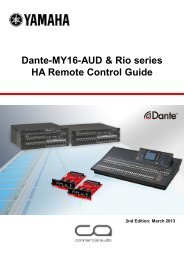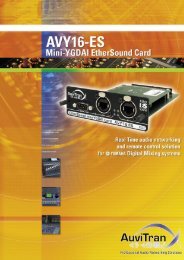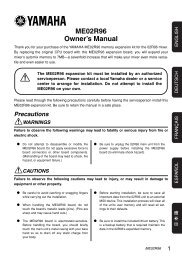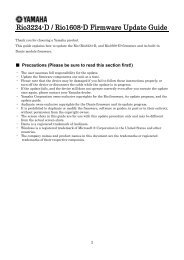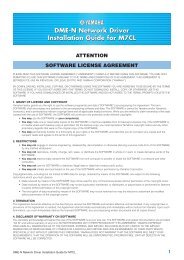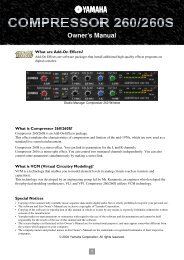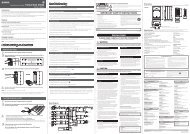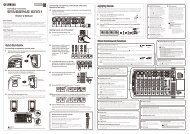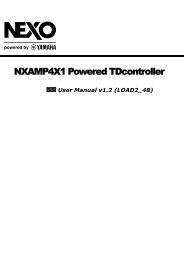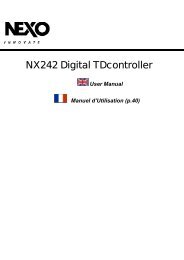Yamaha Digital Audio System Design Guide 8.42MB
Yamaha Digital Audio System Design Guide 8.42MB
Yamaha Digital Audio System Design Guide 8.42MB
You also want an ePaper? Increase the reach of your titles
YUMPU automatically turns print PDFs into web optimized ePapers that Google loves.
43<br />
Product Line Up Product Line Up<br />
Signal Processor<br />
<strong>Digital</strong> Mixing Engine<br />
DME24N<br />
Eight Analog Inputs and Outputs on the DME24N<br />
The DME24N provides eight built-in analog inputs and outputs via Euroblock<br />
terminals on the rear panel. The analog inputs and outputs feature precision 24bit,<br />
96-kHz A/D and D/A converters that deliver top class audio performance.<br />
DME Satellite<br />
High-performance terminal I/O processors for a DME network The DME8i,<br />
DME8o and DME4io are the latest additions to <strong>Yamaha</strong>’s innovative DME series<br />
of digital mixing engines that allow complex audio systems to be designed and<br />
created via software running on a computer. Both types offer greater freedom for<br />
system design while reducing cabling costs, and overall system redundancy and<br />
reliability can be enhanced through<br />
distributed placement of analog I/O<br />
and signal processing.<br />
Each DME Satellite is available in<br />
EtherSound or CobraNet version.<br />
<strong>System</strong> Confi guration using DME Satellite ES Series<br />
• The FOH/monitor, dual-purpose sound reinforcement system shown below is based on EtherSound technology.<br />
• The FOH NAI48-ES and the third on-stage DME8o-ES are connected using Cat5e cables in a simple daisy-chain confi guration. In<br />
addition, the FOH computer (running AVSESMONITOR) is used to monitor each using while also performing patch changes.<br />
• <strong>Audio</strong> signals input to each AD8HR are fed to the M7CL console, and the mixed signals are then sent to each DME8o-ES.<br />
• Each DME8o-ES processes mixed signals using built-in crossover, EQ, delay, limiter, and other effects. As speaker output needs<br />
grow, the system can easily be expanded by connecting additional processors to the daisy chain using Cat5e cables.<br />
• EtherSound cabling latency in this system is extremely low — only 104 µs from stage to FOH and 108.2 µs from FOH to the third<br />
DME8o-ES (at the end of the daisy-chain). At this level, in-ear monitoring* is virtually unaffected.<br />
* Latency for AD/DA conversion and for internal processing by the M7CL and DME8o-ES is not included.<br />
NAI48-ES<br />
DME8o-ES<br />
CAT5e cable<br />
Laptop PC<br />
AVS ES-Monitor<br />
<strong>Yamaha</strong> <strong>Digital</strong> <strong>Audio</strong> <strong>System</strong> <strong>Design</strong><br />
HA Remote (D-sub 9-pin)<br />
D-sub 25-pin (male) cable<br />
Analog cable<br />
Amp & Speakers<br />
MY16-AE<br />
AES/EBU cable<br />
DME8o-ES<br />
CAT5e cable<br />
CAT5e cable<br />
CAT5e cable CAT5e cable<br />
Analog cable<br />
Amp & Speakers<br />
NAI48-ES<br />
AES/EBU cable<br />
MY16-AE<br />
M7CL-32 + MY16-AE + MY16-AE<br />
DME8o-ES<br />
AD8HR x 4<br />
Amp & Speakers<br />
STAGE<br />
RS-232C cable<br />
Analog cable<br />
DME8i-ES/DME8o-ES/DME4io-ES Front Panel<br />
F.O.H<br />
DME8i-ES Rear Panel<br />
Signal Processor<br />
Speaker Processor<br />
SP2060<br />
Full-featured Speaker Processing<br />
in a 1U Space<br />
Speaker processing can be a complicated<br />
Rear Panel<br />
business requiring a substantial array of<br />
equipment, but the <strong>Yamaha</strong> SP2060 offers everything you need in a single rack space. This innovative 24-bit, 96-kHz digital speaker processor<br />
delivers excellent sound quality, an impressive variety of processing functions — gain, delay, PEQ, compressor, crossover, limiter, and an<br />
all-pass fi lter for phase adjustment — and intuitive programming from <strong>Yamaha</strong>’s DME <strong>Design</strong>er application running on a personal computer.<br />
It has two analog inputs and six analog outputs, plus two AES/EBU format digital inputs for connectivity with a broad range of systems. And<br />
if you use <strong>Yamaha</strong> Installation Series Speakers, all you need to do is select one of the many optimized presets provided for great sound with<br />
minimum measurement and setup time. The SP2060 is a compact, portable 1U unit that is ideal for live sound or installations.<br />
Sound <strong>System</strong> Simulator<br />
Y-S 3<br />
Trial and error is one approach to setting up a sound system, but proper analysis and<br />
planning can make the job go a lot faster, and you’re much more likely to achieve professional<br />
results requiring a minimum of post-setup tweaking.<br />
<strong>Yamaha</strong>’s innovative Y-S 3 (<strong>Yamaha</strong> Sound <strong>System</strong> Simulator) software application employs<br />
advanced acoustic modeling technology to precisely simulate the sound pressure level<br />
distribution, frequency, and Installation Series Speakers within a specifi ed acoustic space. It<br />
can also automatically generate optimum system confi gurations and processing profi les for<br />
the specifi ed space, eliminating guesswork and providing accurate guidelines that can help<br />
you to set up the perfect system with minimum effort and expense.<br />
The Y-S 3 application features an advanced graphical interface that makes it easy to specify<br />
the shape and other pertinent characteristics of the target space — right down to average ambient air temperature and humidity — with<br />
equally comprehensive output that provides a graphic representation of the actual sonic distribution within the specifi ed area. There’s even<br />
an “auralization” function that lets you hear the simulated response of the venue with your own ears. Simulation output can be saved in DME<br />
format fi les that can be directly imported into the DME <strong>Design</strong>er application, minimizing the time and effort required to set up a <strong>Yamaha</strong> DME-N<br />
<strong>Digital</strong> Mixing Engine. Y-S 3 automatically calculates optimum speakers and system arrangements (Auto tuning Function), including the array<br />
pan, tilt, spray angle, EQ and gain required to deliver uniform SPL throughout the service area. A preset “Installation Series” library ensures<br />
faultless system planning when using <strong>Yamaha</strong> Installation Series Speakers with PC-N or XP series power amplifi ers and DME digital mixing<br />
engine or SP2060.<br />
Operating procedure<br />
STEP1 STEP2<br />
Choose the shape of the venue for simulation. Select from five<br />
basic types: Rectangular, Fan, Circle, Cross, and Polygon and<br />
adjust the shape of the simulation venue.<br />
Simulation result is displayed with visualized diagrams.<br />
The Y-S 3 STEP4<br />
can display the Contour Figure (visualization).<br />
STEP5<br />
Export the configuration to DME format.<br />
Set the speaker array. Choose the speaker array from the<br />
library (Then set position, tilt, pan, rotate, spray angle, and<br />
symmetry).<br />
The Y-S 3 can display the Sound Pressure Level Distribution<br />
(visualization).<br />
STEP3<br />
Set the DME configuration. You can set delay, PEQ, amp<br />
model, and gain for each speaker.<br />
The Y-S 3 can display the Frequency Characteristics Graph<br />
(visualization).<br />
Check simulation result with your ears using a sound source<br />
(auralization).<br />
<strong>Yamaha</strong> <strong>Digital</strong> <strong>Audio</strong> <strong>System</strong> <strong>Design</strong> 44



